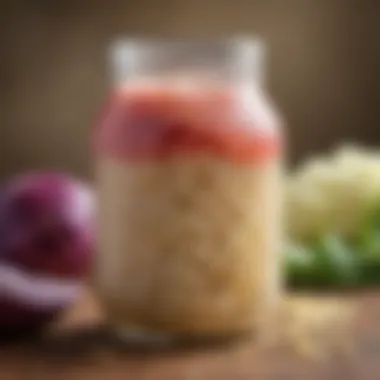Sauerkraut as a Probiotic: Health Benefits and Uses


Intro
Sauerkraut, a staple in various culinary traditions, is more than just a tangy accompaniment to your meals; it's a powerhouse of probiotics. This fermented cabbage dish has been enjoyed for centuries, often lauded for its potential health benefits. Understanding these benefits can illuminate why incorporating sauerkraut into your diet may be a more sound decision than you might have considered.
Fermentation has been an age-old tradition that not only preserves food but also enhances its nutritional profile. In the case of sauerkraut, the process transforms humble cabbage into a symphony of flavors and health benefits. But what exactly makes sauerkraut so special? This article aims to journey through its historical significance, delve into the myriad health benefits, and explore nutritional aspects that render it a superfood in its own right.
As we explore this topic, we’ll look closely at the impact sauerkraut can have on gut health, its preparation methods, and the various types of fermentation. It’s important too, to consider any potential drawbacks to its consumption, making for a complete overview. Finally, we will explore practical ways to incorporate this vibrant food into your meals, ensuring you can relish both its taste and health advantages.
Let’s set the stage for diving into the multifaceted world of sauerkraut.
Prelude to Probiotics
Probiotics are more than just a buzzword in the wellness community; they represent a fundamental component of our diet that can have significant impacts on overall health. Adopting a deeper understanding of probiotics is essential, particularly in the context of fermented foods like sauerkraut, which have been staples in various cultures for centuries. The central benefits of probiotics include promoting gut health, improving digestion, and potentially enhancing immune function. As more people turn their attention toward natural health solutions, knowing what probiotics are and their sources becomes crucial.
Definition of Probiotics
At its core, probiotics are live microorganisms that, when consumed in adequate amounts, confer a health benefit on the host. Generally, these microorganisms are primarily beneficial strains of bacteria and yeasts. They are credited with maintaining gut equilibrium and can even alleviate digestive troubles. Often thought of in tandem with yogurt or kefir, sauerkraut deserves its place in the spotlight for its probiotic-rich profile.
Remarkably, not all probiotics are created equal. They vary tremendously in terms of strains and benefits. For instance, Lactobacillus and Bifidobacterium are two of the most researched probiotic strains, known for their roles in enhancing gut flora and improving digestion. Getting enough of these healthy bacteria, especially from fermented foods like sauerkraut, helps us ward off ailments stemming from an imbalance in gut health.
Historical Context of Probiotic Foods
The journey of probiotic foods like sauerkraut goes back thousands of years. Originating in China around 2000 B.C., fermentation processes were discovered as a means to preserve food and enhance flavors. Sauerkraut, in particular, found a cozy home in European cuisines, becoming a staple in countries like Germany and Poland.
The historical incorporation of fermentation into dietary practices was not merely coincidental. It arose from a necessity to preserve food through harsh winters and long voyages. Sailors, for example, relied on sauerkraut to stave off scurvy. It provides both lasting nourishment and health benefits as those microorganisms worked their magic within the gut. What started as a means of preservation has transitioned into a culinary staple celebrated for its health benefits today.
"The cultural significance of sauerkraut extends beyond mere nutrition. It’s a testament to our ability to harness nature and time—through fermentation—resulting in a truly probiotic-rich delight."
In unraveling these layers of history, we find a compelling backdrop that strengthens our connection to sauerkraut not only as a flavorful addition to meals but as a gift of nature, capable of fostering better health.
This exploration of probiotics provides not just scientific insight but cultural understanding, helping culinary enthusiasts appreciate the integral role of foods like sauerkraut in fostering digestive wellness.
Understanding Sauerkraut
To fully appreciate sauerkraut as a probiotic food, it’s crucial to dive into what sauerkraut actually is and its role in various cultures. This section aims to illuminate the essence of sauerkraut, its benefits, and its historical significance, paving the way for understanding which aspects contribute to its status as a probiotic powerhouse.
What is Sauerkraut?
Sauerkraut is essentially fermented cabbage, resulting from a natural process of lacto-fermentation. The process begins with finely chopped or shredded cabbage mixed with salt. This mixture then undergoes fermentation—a magical transformation where beneficial bacteria break down the sugars in the cabbage, creating lactic acid. It’s a simple yet intricate dance of microbial life that not only preserves the cabbage but also unlocks a trove of health benefits.
The unique tangy flavor and crunchy texture of sauerkraut can be attributed to this fermentation process. Transforming a humble vegetable into something extraordinary makes it much more than a mere condiment; it’s a nutritional powerhouse packed with probiotics, vitamins, and minerals.
The potential health benefits of sauerkraut are vast, especially its ability to improve gut health. When regularly consumed, it serves as a tonic for the digestive system, often leading to better absorption of nutrients and overall improved health.
Cultural Significance of Sauerkraut
Sauerkraut is not just a modern culinary delight; it holds deep cultural roots that span centuries and continents. Traditionally associated with German cuisine, where it is often paired with sausage or served as a side dish, sauerkraut has also found its place in various other cultures. In Poland, it’s a key ingredient in bigos, or hunter's stew, while in Korea, its counterpart, kimchi, serves a similar purpose.


In many cultures, sauerkraut represents resilience and community. Historically, fermenting cabbage was a way to preserve food through harsh winters, indicating a resourcefulness that has survived through generations. For those who made sauerkraut, it was more than just about sustenance; it was about sharing, nurturing, and maintaining traditions.
"Culture is a way of coping with the world by defining it in detail." – Malinowski
Today, the renewed interest in fermentation and probiotics reflects a growing awareness of gut health's importance. The journey of sauerkraut from an everyday food item to a celebrated superfood demonstrates how cultural practices can evolve, yet remain anchored in tradition.
By exploring sauerkraut through these lenses—its definition and cultural significance—readers can appreciate not just the health benefits, but also the rich tapestry that this fermented food weaves into our lives. As culinary enthusiasts delve into their kitchens, understanding these elements can inspire more creative and thoughtful uses of sauerkraut in everyday cooking.
Health Benefits of Sauerkraut
Sauerkraut, often considered a humble side dish, boasts a treasure chest of health benefits that deserve a spotlight. While many might associate it purely with taste, the true value lies in its probiotic properties, which can profoundly impact our health. Exploring these benefits not only accentuates the role of sauerkraut in diets but also enables us to appreciate its significance in maintaining overall well-being. The benefits range from aiding digestion to bolstering immunity, rooted in the fermentation process that creates this unique food.
Enhancing Digestive Health
Role of Probiotics in Digestion
The cornerstone of sauerkraut’s health benefits is its rich supply of probiotics. These live microorganisms serve as natural allies to our guts. When consumed, they help maintain a balance in our digestive system, which often gets thrown off by diet, stress, or illness. Probiotics enhance the digestion of nutrients, primarily by breaking down complex carbohydrates that our bodies struggle to digest. They also promote a healthier gut environment by producing short-chain fatty acids that nourish the gut lining.
One key characteristic of probiotics in digestion is their ability to ease symptoms of irritable bowel syndrome, commonly known as IBS. For many people, including sauerkraut in their meals can lead to noticeable improvements in digestion and comfort. This fermented food doesn’t just sit inert in your stomach; it actively works to improve gut function and efficiency.
The unique feature of probiotics in digestion is the way they interact with gut flora. When you introduce live cultures from sauerkraut into your system, you're not just adding tasty crunch but are also creating a more dynamic gut microbiome. As beneficial bacteria flourish, they take the reins over harmful bacteria, leading to a healthier automated process. As this happens, some folks might experience mild gas or bloating at first, but this often settles as the body adjusts.
Effect on Gut Microbiota
The effect of sauerkraut on gut microbiota is substantial. Our gut is home to trillions of bacteria, playing a crucial role in digestion, fermentation, and even metabolism. When sauerkraut enters the scene, it can replenish these beneficial bacteria, making it a go-to for many looking to enhance their gut health.
A key characteristic here is the ability of diverse strains of probiotics in sauerkraut to contribute to the overall diversity of gut bacteria. A diverse microbiota is often associated with better health outcomes. Studies often show that diets rich in fermented foods, like sauerkraut, can significantly increase gut biodiversity, which subsequently improves digestion and overall gut function.
On a practical note, the unique feature of increasing gut microbiota diversity means less chance for harmful bacteria to dominate, which is crucial for those prone to infections or digestive disorders. However, individuals with certain gastrointestinal conditions should approach with caution, as sudden changes in gut flora might lead to discomfort initially.
Impact on Immune System
Sauerkraut doesn’t just impact the digestive system; it plays a pivotal role in fortifying the immune system as well. A healthy gut is often referred to as the foundation of a strong immune system, as a significant percentage of the immune cells are actually located in the gut. Regular consumption of sauerkraut can help modulate immune responses and enhance the body's defense mechanisms against pathogens.
Nutritional Profile of Sauerkraut
Vitamins and Minerals
Besides being a probiotic powerhouse, sauerkraut provides a small yet impressive array of vitamins and minerals. It's particularly rich in vitamin C, known for its antioxidant properties, which help fend off illness and promote healing. Additionally, sauerkraut contains vitamin K, crucial for blood clotting and bone health.
One standout feature is that these nutrients are not just present but are made more bioavailable through fermentation. This means your body can easily absorb them, encouraging optimal nutrient uptake.
For many, this attribute transforms sauerkraut into not just a condiment but a functional food that can elevate overall nutritional intake without substantial calories.
Low-Calorie Content
Low-calorie content is another gem of sauerkraut. For those watching their waistlines, this fermented fare is a perfect addition to meals. With minimal calories but packed with flavor, it allows you to enjoy a satisfying dish without the guilt that often accompanies richer foods.
The unique aspect of its low-calorie count is coupled with its high fiber content, which can help in weight management. As fiber takes longer to digest, it aids in prolonging feelings of fullness, making it an ideal companion for main meals or snacks.


Embracing sauerkraut isn't just about indulging in unique flavors; it’s about enhancing health through a simple, yet powerful addition to the diet.
The Science Behind Fermentation
Understanding the science of fermentation is crucial for comprehending how sauerkraut functions as a probiotic food. Fermentation not only serves as a preservation method but also transforms raw ingredients into powerhouses of flavor and nutrition. The art and science involved in this process can affect the final product’s taste, texture, and health benefits.
Fermentation Process Explained
At its core, fermentation is a natural metabolic process that converts sugars into acids, gases, or alcohol. In the case of sauerkraut, we observe lactic acid fermentation. This process involves the breakdown of carbohydrates by bacteria, particularly Lactobacillus species. These bacteria thrive in anaerobic conditions, meaning they do not require oxygen, which is integral to producing the tangy flavor typical of sauerkraut.
During fermentation, cabbage is shredded and mixed with salt. The salt encourages the growth of desirable bacteria while inhibiting unwanted microorganisms. As these beneficial bacteria reproduce, they produce lactic acid, which not only preserves the cabbage but also enhances its probiotic profile. The result is a vibrant, tangy product that can be enjoyed for its depth of flavor and its healthful benefits.
Types of Fermentation
When it comes to fermenting foods like sauerkraut, you might encounter different types of fermentation, each with distinct characteristics. The most common forms are lactic acid fermentation and the dichotomy between wild and cultured fermentation.
Lactic Acid Fermentation
Lactic acid fermentation is notable for its simplicity and efficacy in preserving food. One of its most significant contributions to sauerkraut is the enhancement of the food’s digestibility. Through this process, the bacteria produce not just lactic acid but also other beneficial compounds, promoting gut health. This fermentation leads to a decrease in pH, making it an inhospitable environment for spoilage-causing bacteria, thus preserving the integrity of the sauerkraut.
Another essential aspect of lactic acid fermentation is its contribution to flavor development. This method imparts a distinct sourness that many enjoy with their meals. Whereas some methods might take longer and yield less desirable flavors, lactic acid fermentation generally provides a reliable and tasty result. Additionally, it is often regarded as a universally beneficial fermentation method due to its probiotic contents, offering potential digestive perks and overall gut balance for those who include it as part of their diet.
Wild vs. Cultured Fermentation
When discussing fermentation types, one must also consider the debate between wild and cultured fermentation. Wild fermentation relies on the naturally occurring microorganisms present in the environment, such as on the cabbage leaves or in the air. This method can yield unique flavors, as each batch has the potential to be different based on environmental factors. However, it may also carry the risk of contaminants if not carefully monitored.
On the other hand, cultured fermentation utilizes specific strains of bacteria, often added directly to the food. This provides a level of predictability and control, resulting in a consistent flavor and probiotic profile. Furthermore, cultured methods may lead to a quicker fermentation period, perfect for those who don’t want to wait weeks to experience the benefits of their sauerkraut.
Both methods have their advantages. Wild fermentation can create distinct and varied flavors, appealing to culinary adventurers who seek a more artisanal touch. Cultured fermentation offers reliability and less unpredictability, making it suitable for those who wish to ensure a specific health outcome or flavor profile.
With these insights into fermentation, we can appreciate the delicate balance between science and art that gives sauerkraut its unique characteristics and benefits.
Incorporating Sauerkraut into Your Diet
In the quest for better health, understanding how to incorporate sauerkraut into your daily routine can be surprisingly pivotal. This fermented wonder food isn’t merely a side dish; it's a robust tool for enhancing your gut health and overall nutrition. Sauerkraut not only adds a deliciously tangy crunch to meals, but it also packs a probiotic punch, which can support digestive health, boost your immune system, and provide essential vitamins and minerals. In light of this, learning to integrate sauerkraut into your meals can be both a delicious endeavor and a means of embracing health benefits.
Culinary Uses of Sauerkraut
When it comes to culinary applications, sauerkraut shines as a versatile ingredient that can elevate the taste of varied dishes. Traditionally, it’s often seen paired with sausages or as a topping for hot dogs, providing a perfect crunchy contrast. However, its uses extend far beyond this. You might consider tossing it into a stir-fry or using it as a base for a savory salad. Its acidity can also cut through the richness of creamy dishes, adding balance and depth.
- Flavor enhancer: Sauerkraut can intensify flavors in a dish, making it a secret weapon in your culinary arsenal.
- Texture contrast: The crispness offers a delightful crunch, invigorating dishes that might otherwise seem one-dimensional.
Quick and Easy Recipes Featuring Sauerkraut
Classic Sauerkraut Dishes
Classic sauerkraut dishes are often rooted in tradition yet remain relevant today. Consider a simple Reuben sandwich, where the combination of rye bread, corned beef, Swiss cheese, and, of course, sauerkraut creates a symphony of flavors. The standout here is definitely the sauerkraut, which not only uplift the entire experience but also underlines the importance of fermented foods in comfort cuisine. Its tartness cuts through the richness, creating a well-rounded meal that many find enjoyable. This kind of dish demonstrates how sauerkraut can transition from being an overlooked side to a centerpiece of the plate.
- Benefits: Incorporating sauerkraut here provides digestion benefits, while also delivering vitamins.
- Disadvantage: Too much sauerkraut can overpower the flavors if not balanced well, so moderation is key.


Sauerkraut in Modern Cuisine
In modern culinary settings, sauerkraut has found its way into unexpected dishes, showcasing its adaptability and keeping the tradition alive. Think about sauerkraut tacos, where spicy, seasoned meat is complemented with the bright acidity of fermented cabbage. It’s a delightful twist that invites creativity in the kitchen. Modern chefs often embrace sauerkraut’s probiotic benefits, infusing it into salads or grain bowls.
Consequently, this approach introduces several advantages:
- Nutritional boost: Adding sauerkraut increases fiber and probiotic content in these meals.
- Balancing flavors: The tanginess melds beautifully with various ingredients, encouraging combinations that might not have been considered prior.
In summary, incorporating sauerkraut into your diet doesn't simply yield a flavorful meal; it supports well-being on several levels. By using this ordinary, yet extraordinary, food in everyday cooking, one can reap health benefits while adding diversity to culinary experiences. The key is to get creative and explore the depth of taste sauerkraut brings to the table.
Potential Downsides of Consuming Sauerkraut
While sauerkraut is often celebrated for its myriad health benefits, it's not all sunshine and rainbows when it comes to this fermented delight. Understanding the potential downsides is crucial for those seeking to enjoy it responsibly. An informed approach can prevent any unwanted side effects and accommodate personal dietary needs. This section examines the possible negative impacts of consuming sauerkraut, primarily focusing on side effects and sodium content considerations.
Possible Side Effects
Sauerkraut is usually safe for most people, but it can cause some unexpected issues for certain individuals. For instance, if someone is new to eating fermented foods, they might experience digestive discomfort, including gas, bloating, or diarrhea. This is often due to the sudden increase in probiotics introduced to the gut. It's akin to throwing a party that your gut wasn't prepared for; sometimes, the guests (bacteria) take a while to settle in.
Some people may also find that they are sensitive to histamines, which are found in fermented products. Due to fermentation, sauerkraut has higher histamine levels and could trigger allergic-like reactions in sensitive individuals. Symptoms might include headaches, skin rashes, or digestive upset.
"Moderation is key. Start with small amounts and increase as your body adjusts, if you experience any side effects."
Those with certain medical conditions, such as irritable bowel syndrome or other gastrointestinal disorders, should tread lightly. Consulting with a healthcare professional can help in determining the right approach to incorporating sauerkraut into one's diet, ensuring that it complements, rather than complicates, one’s digestive health.
Sodium Content Considerations
Another factor to consider when enjoying sauerkraut is its sodium content. Traditional methods of making sauerkraut usually involve adding salt, which plays a pivotal role in the fermentation process. This salt acts as a preservative and flavor enhancer, but it also means that sauerkraut can be quite salty, and excessive intake might pose health risks, particularly for those with high blood pressure or heart disease.
A typical serving of sauerkraut can contain between 300 to 600 mg of sodium, which is a significant portion of the daily recommended intake. Thus, those monitoring their sodium consumption should be mindful of portion sizes and maybe opt for low-sodium varieties when possible. Alternatively, rinsing sauerkraut before consumption can help wash away some of that excess salt, making it a bit more heart-friendly without sacrificing too much flavor.
In summary, while sauerkraut packs a punch in terms of health benefits, it's essential to be aware of these potential downsides. A measured and informed approach will allow culinary enthusiasts to enjoy this tangy superfood while minimizing any adverse effects.
Ending
In summary, the exploration of sauerkraut as a probiotic reveals a significant impact on gut health and overall well-being. As we have discussed, sauerkraut offers not only a tangy addition to meals but also a rich source of beneficial bacteria that can enhance our digestive systems. This fermented food is not only rooted in historical traditions but also serves modern dietary needs, making it a unique fusion of culture and health benefits.
The Overall Value of Sauerkraut as a Probiotic
The value of sauerkraut as a probiotic extends into several dimensions. Primarily, its fermentation process introduces a variety of live cultures that are vital for maintaining a balanced gut microbiome. Evidence suggests that regular consumption can lead to improved digestion, reduction in gastrointestinal discomfort, and potentially an enhancement of immune responses.
Furthermore, the high vitamin C content and presence of B vitamins make it an excellent option for boosting nutrition. Sauerkraut easily fits into a wide array of diets, whether one is vegan, vegetarian, or even following a low-carb regimen. Its versatility isn't just a culinary charm; it ensures everyone can reap its probiotic benefits.
Most importantly, it presents an inviting opportunity for individuals to take control over their health. By incorporating sauerkraut into daily meals, they’re not just adding flavor; they’re fostering a healthier lifestyle.
"Incorporating foods like sauerkraut into your diet can be a subtle yet effective way to promote digestive health."
Future Perspectives on Probiotics in Diet
Looking ahead, the understanding and relevance of probiotics in our diets are likely only to increase. With ongoing research unveiling new strains of probiotics and their specific benefits, sauerkraut stands as an exemplary representative of how traditional methods can provide modern solutions.
Future discussions might revolve around variances in probiotic efficacy based on diverse diets. Will the perceived benefits shift as we learn more about personal microbiomes? The interest in fermented foods like sauerkraut is a growing trend, influenced by rising awareness of gut health's pivotal role in overall wellness.
Moreover, as people become more adventurous in the kitchen, the incorporation of sauerkraut will evolve beyond typical recipes—think fusion dishes or gourmet presentations. The key lies in breaking down the barriers of traditional perceptions surrounding fermented foods. Embracing sauerkraut not just as a side but as an integral part of a dish could redefine culinary experiences while simultaneously enhancing health outcomes.
All in all, as the field evolves, the humble sauerkraut will likely continue to take center stage in the dialogue about health, making it a staple worth embracing for years to come.







